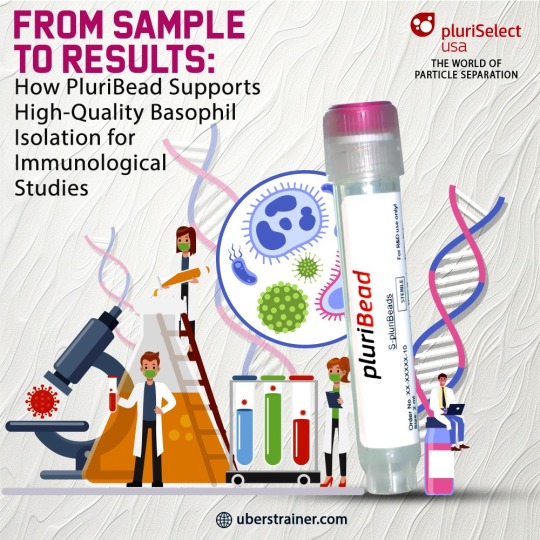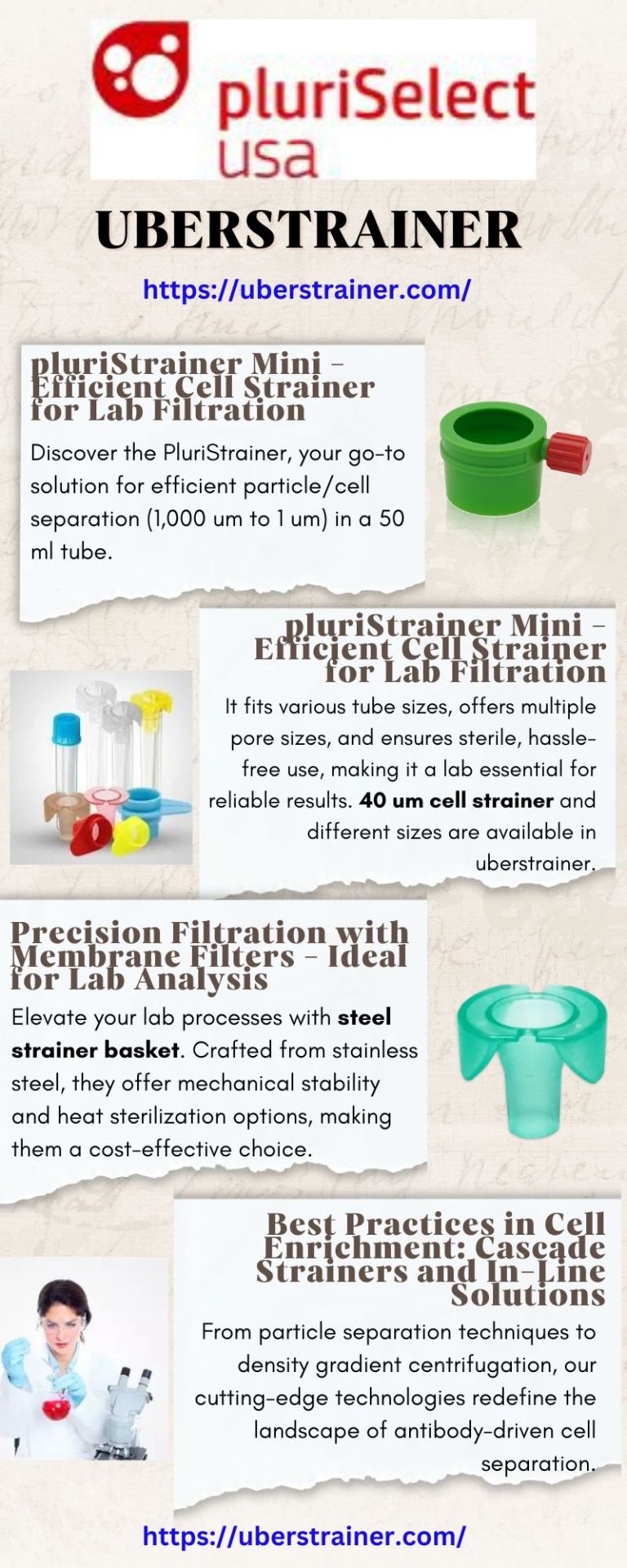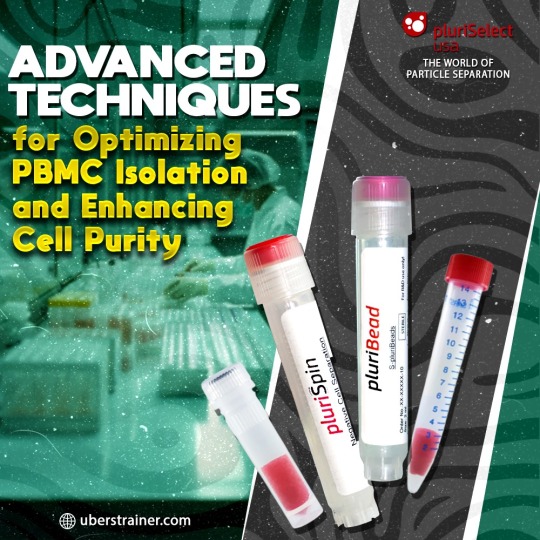#uberstrainer
Text
Human Monocyte Enrichment with pluriSpin: The Ultimate Tool for Researchers

This blog introduces the pluriSpin system as the ultimate tool for researchers, providing precise, versatile, and accessible human monocyte enrichment with highly viable and functional cells.
In the dynamic field of cellular research, the enrichment of specific cell populations holds the key to unlocking crucial insights. Human monocytes, as key players in the immune system, are often the focus of investigations exploring their roles in inflammation, immunity, and disease. This blog explores the significance of human monocytes in research and why researchers require the best tool for cell enrichment techniques, shedding light on how the pluriSpin system emerges as the ultimate solution.
Human Monocytes: Navigating the Complexity of Immune Responses
Understanding the Role of Human Monocytes
Human monocytes are versatile immune cells, serving as the precursors to macrophages and dendritic cells. Their ability to navigate through the bloodstream, infiltrate tissues, and respond to inflammatory signals makes them pivotal in immune surveillance and defense. Researchers delve into the intricacies of monocyte behavior to unravel their involvement in various physiological and pathological processes.
Key Applications of Human Monocyte Research
Inflammation Studies: Monocytes play a central role in the inflammatory response. Investigating their behavior provides insights into the mechanisms underlying inflammation and its resolution.
Immune System Modulation: Understanding how monocytes contribute to immune system modulation is essential for developing targeted therapies for autoimmune diseases and immunodeficiencies.
Disease Pathogenesis: Researchers explore the involvement of monocytes in diseases such as atherosclerosis, cancer, and infectious diseases to identify potential therapeutic targets.
Why Researchers Require the Best Tool for Human Monocyte Enrichment
Precision in Cell Isolation: A Prerequisite for Accurate Results
Achieving reliable and reproducible results in human monocyte research hinges on the precision of cell separation technology. Enriching monocytes with minimal contamination ensures that downstream experiments are reflective of the true characteristics of these immune cells. Researchers require a tool that guarantees untouched and highly purified monocytes for robust and accurate analyses.
Compatibility with Diverse Applications
Human monocyte research spans a spectrum of applications, from immune cell stimulation studies to cytotoxicity assays. Researchers need a versatile tool that not only ensures the purity of isolated monocytes but also maintains their functionality. The enriched cells should be immediately available for cultivation, differentiation, compound screening, and other high-throughput screening (HTS) applications, catering to the diverse needs of researchers in the field.
Accessibility and Ease of Use
The ideal tool for human monocyte enrichment should not be confined to specialized laboratories with advanced equipment. Accessibility is key, and researchers, regardless of their laboratory setup, should be able to incorporate the tool into their workflows seamlessly. A user-friendly system that does not demand special training or additional equipment democratizes the process, empowering researchers across various settings.
Unlocking the Potential: pluriSpin as the Ultimate Tool
The pluriSpin® Advantage: Streamlined and Reliable
The pluriSpin system, a breakthrough in negative cell isolation, emerges as the ultimate tool for human monocyte enrichment. Its unique approach directly from whole blood, buffy coat, or cord blood ensures the isolation of highly purified and untouched cells in a single step. The absence of magnets or columns minimizes the risk of activating or damaging the cells of interest, guaranteeing a streamlined and reliable process.
Immunodensity Cell Isolation Reagent: Ensuring Success
At the core of the pluriSpin® system lies the immunodensity cell isolation reagent (pluriSpin®). This meticulously designed solution facilitates the binding of unwanted cells, setting the stage for a seamless density gradient centrifugation. The result is a pool of highly purified monocytes, ready for immediate application in a myriad of research endeavors.
Fast, Easy, and Accessible
PluriSpin® excels in its simplicity. The workflow is fast, efficient, and does not require specialized instruments. With standard density gradient centrifugation and a mixing device, researchers can incorporate pluriSpin® into their existing laboratory setups without the need for extensive training or additional equipment.
Highly Viable and Functional Cells
The hallmark of pluriSpin® is its ability to provide highly viable and functional cells. Isolated monocytes retain their functionality with minimal manipulation, making them perfect for a wide range of applications, including flow cytometry-compatible studies. The absence of labels or magnetic beads ensures that the cells remain in their native state, allowing for more accurate downstream analyses.
Elevating Human Monocyte Research with pluriSpin®
In the quest for understanding the intricacies of human monocytes and their pivotal roles in immunity and disease, researchers need a tool that aligns with the complexities of their work. The pluriSpin® system, with its precision, versatility, accessibility, and the promise of highly viable cells, stands as the ultimate solution for cell enrichment. As researchers continue to unravel the mysteries of the immune system and its responses, pluriSpin® becomes an indispensable companion, opening new avenues for innovative discoveries in cellular research.
Explore the science behind cascade straining with strainer cascade technology. Learn how this innovative method elevates particle separation, offering unmatched precision and efficiency for your diverse cell separation needs.
2 notes
·
View notes
Text
A Brief Overview of Human CD34+ Hematopoietic Stem Cells
CD34 expression in hematopoietic stem cells is significant for cell isolation techniques. CD34+ cells have diverse functions and potential applications in medical research. However, isolating and preserving these cells pose challenges.
The human body consists of several interconnected systems that rely on one another to preserve equilibrium. Within these systems, there are specialized cells that carry out specific functions essential for various processes. One such example is the immune system, which safeguards the body against foreign invaders using specialized blood cells. Among these blood cells, hematopoietic stem cells found in the bone marrow play a crucial role in the development of different types of blood cells.
This blog delves into the significance of CD34 expression and highlights the techniques used for cell enrichment in the study of hematopoietic stem cells.

What Are Hematopoietic Stem Cells?
Hematopoietic stem cells (HSCs), characterized by the presence of the CD34+ marker, possess a unique characteristic known as multipotency. This means that they have the ability to give rise to a diverse range of mature blood cells, including leukocytes, erythrocytes, and platelets. HSCs exhibit self-renewal capabilities, enabling them to regenerate and sustain themselves. They have the remarkable capacity to differentiate into almost any type of blood cell required, making them an integral component of the hematopoietic system.
Understanding CD34: A Cell Marker for Hematopoietic Stem Cells
Cell markers, also known as surface antigens, are molecules present on the cell membrane that serve specific functions related to the cell's role in the body. These proteins are crucial for identifying and characterizing different cell types. CD34, also known as sialomucin, is a transmembrane protein that spans the cell membrane once. It is primarily expressed in certain vascular and hematopoietic tissues.
The Significance of CD34 Expression
The presence of CD34 markers and the utilization of effective cell enrichment techniques are essential in the identification and isolation of hematopoietic stem cells. Scientists employ various techniques for cell separation, including those based on the physical properties of cells and those that utilize antibodies to target specific surface antigens. CD34 expression on the cell membrane enables the binding of CD34-specific antibodies to hematopoietic stem cells, facilitating their identification and isolation.
Using Pluribead to Enrich CD34+ Cell Samples
Pluribead is a technique where a particular antibody directly binds to the target cells, enabling their separation from other undesirable cells during subsequent enrichment steps. The unbound cells are removed, leaving only the desired cells. To immobilize the labeled cells, a cell strainer or magnets can be used when coupled with a solid phase. This approach can be used with various sample materials, such as PBMC, secretion or excretion material, buffy coat, whole blood, brain homogenate, spleen, liver, and so on.
In conclusion, hematopoietic stem cells (HSCs) with CD34 expression play a critical role in the development and regeneration of different types of blood cells. Understanding the importance of CD34 markers and employing effective cell separation techniques are key to studying and harnessing the potential of these stem cells for medical research and treatment. Explore the possibilities of cell enrichment techniques and uncover the potential of hematopoietic stem cells in advancing medical science. Start your journey today!
0 notes
Text
The Best Cell Strainers For Preparing Flow Cytometry Samples
Do you require cell strainers for the preparation of flow cytometry samples? Let’s find out the details of the best cell strainers.

It is extremely important to properly prepare the sample in order to achieve a smooth cell flow. The type of cells to be examined, as well as any other potential impediments to the flow, must be taken into account.
Running your sample through the best Lab Cell Strainers, which is essentially a piece of mesh with a specific porosity size to create a single-cell suspension, is a common part of proper preparation.
Cell Strainers
Cell strainers are used to isolate primary cells from test tubes or conical tubes in order to obtain single-cell suspensions. They are typically color-coded to assist you in determining which cell strainers to use for different tube sizes. They come in both non-sterile and sterile varieties. Cell strainers are made of nylon mesh with pores that are evenly spaced.
How Do The Cell Strainers Work?
Cell strainers remove debris or clumps from samples, allowing cells to be isolated for further testing. The cell strainers fit on the tops of various size sample tubes to help create a tight fit, so the material must pass through the strainer.
Only certain materials can pass through the mesh, which is made up of different sizes. It allows for the separation of materials based on size, allowing for the isolation of a specific material from the rest of the sample.
Use Our Cell Strainers For:
Single-cell suspensions of blood cells are prepared from bone marrow, pancreas, thymus, and other sources.
Dissociation of tissue for single-cell suspension and isolation
Filtered and isolated primary and cell culture cells
Flow Cytometry Sample Preparation
How Our Range Of All-Star Strainer Can Help?
Pluriselect has a large selection of best Lab Cell Strainers to meet almost any need. You can select the ideal device for your sample preparation in meh sizes ranging from 1 m to 1000 m, PET or nylon fibers, sterile or non-sterile, small volumes up to 800 L or in-line-strainer, back-flush capability or not. The following are examples of straining/filtration devices:
PluriStrainer
Available in 15 mesh sizes
Fits in 50 ml tubes
Low pressure compatible
Stackable as cascade
Centrifugable with Connector Ring
Sterile, single-packed
ÜberStrainer
Available in 15 mesh sizes
Fits in 2, 15, 1.5, and 50 ml tubes
Low pressure compatible
Process unlimited amount of liquid
Centrifugable
Sterile, single-packed
PluriStrainer Mini
Available in 6 mesh sizes
Fits tubes ranging in size from 1.5 mL to 15 mL
Fills the gap for small sample volumes
Autoclavable
Centrifugable
Sterile, bulk-packed
Syringe Strainer
Available in 15 mesh sizes
Sterile and non-sterile varieties
Membrane Strainer
The exclusion limit for pore size is well-defined (available with 1, 3, 5, and 8 m pores).
Non-hygroscopic membrane
Low non-specific protein binding
Biologically inert, non-cytotoxic
Excellent chemical and temperature resistance
Steel Basket-Strainer
Fits in a 50 ml standard tube
Excellent mechanical stability of SS 316 steel
Perfect to extract liquids from a porous material
Reusable
Re-Strainer (In-Line-Strainer)
Available in 15 mesh sizes
6 ml recovery reservoir
Two femaleluer-lock-ports
Housing material is LD-PE (Low-Density Polyethylene)
Withstand pressure up to 3.5 kg/cm2
Are you looking for the best cell strainer for your research? To order high-quality cell or particle separation products, please visit our website.
0 notes
Text
Different Types of Strainers
Uber Strainer has brought the most incredible variety of straining/filtration apparatuses. If you want to have a perfect appliance for your sample preparation, then you have come to the right place. In addition, our straining/filtration devices are available in meh sizes between 1 µm and 1000 µm, PET or nylon fibers, sterile or non-sterile, small volumes up to 800 µL or in-line-strainer, back-flush possibility, along with many features.

All strainers are used for the sample preparation – these filters can't separate cells of slightly different sizes. Mesh openings of strainers are three-dimensional "squares." As the yield of waving, it is formed by fibers of > 30 µm thickness. Moreover, cells have a very flexible membrane and squeeze through mesh openings that are much less than the cell diameter. However, we offer six varieties of straining/filtering apparatuses. They are described below:
1. Pluristrainer
The PluriStrainer is a versatile sieving device used for particle/cell separation. It separates the cell whose size ranges between 1,000 um and 1 um diameter. It gets fitted into any 50 ml standard tube. It can be reversed over to flush back the sample from the opening. A funnel expands the strainer volume from 6 to 24 ml. A connector ring having aLuer-lock cap produces an airtight working compartment strainer tube. A closed lid enables the sample on the mesh. The open cap can be utilized to enhance flow by removing the 50 ml tube with a syringe.
2. Uberstrainer
The Uberstrainer is a sample preparation device that enhances the usage of mesh devices to improve selection, separation, and isolation. Its modular layout offers it versatility and a wide range of functionality.
It consists of a screw cap with a Luer-lock adaptor. It has a 6 ml housing with an integrated mesh in 15 sizes ranging from 1 um to 500 um. A connector ring having a Luer-lock cap produces an airtight working connection to a 50 ml standard tube. It gets fitted into any 15 ml, 2 ml, and 1.5 ml standard tube. These standard tubes offer a wide variety of separation of cells along with pressure or under pressure.
3. Mini-Strainer
Mini-Strainer is built for small sample volumes ranging up to 700 ul. They get fitted perfectly in nearly any reaction tube of sizes ranging from 15 ml to 1.5ml, 24 / 48 well plates. You can select the mesh size between 5 um and 200 um. The 40 um and 70 um are primarily utilized for sample preparation for further FACS analysis.
4. Syringe-strainer
The Syringe-strainer can be tied to a syringe or a tube via the screw cap along with a Luer-Lock port. This product family is available in 15 mesh sizes ranging from 1 um to 500 um in a sterile or non-sterile variation. The syringe filter can be utilized with positive or negative pressure.
5. Mini-membrane Strainer
Mini-Membrane-Strainer comprises a PET membrane with a distinctive pore opening (etching technology) of different sizes: 1 um, 3 um, 5 um, and 8 um. They can be submerged in a 24 well tissue plate with the cover on top.
6. Re-Strainer (In-Line-Strainer)
The Restrainer is a sample separation device with a 6 ml recovery reservoir that can be accessed by unscrewing the cap. The Restrainer consists of two female Luer-lock-ports. These ports can be utilized to connect several Re-Strainer to a filter cascade (male to male Luer-lock connector) or combine the Re-Strainer as an in-line-strainer via Luer lock tube adapter. You can select from 15 different mesh sizes (1 um to 500 um).
0 notes
Text

PBS Is Used For A Variety Of Cell Culture Applications.
Phosphate Buffered Saline is formulated without calcium and magnesium for rinsing chelators from the culture before cell dissociation. Unleash the potential of cell enrichment techniques through innovative antibody-based separation techniques. Explore effective methods for enhancing cell isolation and redefining your research endeavors.
3 notes
·
View notes
Text

From Sample to Results: How PluriBead Supports High-Quality Basophil Isolation for Immunological Studies
PluriBead provides a streamlined, non-magnetic solution for efficient basophil isolation, simplifying the process and enhancing sample quality through advanced antibody cell separation techniques.
When it comes to high-quality cell isolation, the right technology can make all the difference. For researchers focused on basophil isolation and related immunological studies, PluriBead offers a cutting-edge solution that simplifies and enhances the process. This blog will explore how PluriBead supports efficient basophil isolation using advanced antibody cell separation techniques, delivering reliable results for your research needs.
What Makes PluriBead Stand Out?
PluriBead is a unique cell separation technology that distinguishes itself by working without magnetic components. This non-magnetic approach is designed to streamline the process, making it simpler and more efficient. Unlike traditional methods that require complex procedures or additional equipment, PluriBead offers a straightforward solution: sieve the PluriBeads with bound target cells through a lab cell strainer. The beads with your target cells remain on top, while unwanted cells pass through. After a simple detachment step, your target cells are ready for further analysis.
Key Features of PluriBead for Basophil Isolation
No Sample Preparation Required: One of the main advantages of PluriBead is its simplicity. You can use samples ranging from 200 µl to 45 ml without the need for gradient centrifugation, erythrolysis, or other pre-treatments. This saves time and reduces the complexity of your workflow.
Versatile Sample Materials: PluriBead can handle a wide range of sample types, including whole blood, buffy coat, PBMCs, and various tissues like brain homogenates, spleen, and liver. This versatility ensures that you can adapt the technology to your specific research needs.
High Range of Species: Whether you're working with human, mouse, rat, bovine, canine, or sheep samples, PluriBead accommodates various species. This broad application range is beneficial for comparative studies and cross-species research.
Fast and Gentle Isolation: PluriBead supports fast isolation starting from just 5 minutes. Its gentle approach ensures a high yield of viable cells, minimizing sample requirements and preserving the integrity of your basophils.
Universal Beads for Any Antibody: The PluriBead technology is compatible with any external antibody, providing flexibility in selecting the most suitable markers for your research.
Simultaneous and Sequential Cell Isolation: With PluriBead Cascade straining, you can separate two different cell types simultaneously from a single sample. Additionally, sequential isolation allows you to target up to six different cells from one sample, enhancing your research efficiency.
How PluriBead Enhances Basophil Isolation
Basophils play a critical role in immune responses and are often challenging to isolate due to their low abundance and delicate nature. PluriBead’s non-magnetic cell separation technology is particularly advantageous for isolating these cells. By leveraging PluriBead, researchers can achieve high-purity basophil samples without the complications associated with magnetic bead-based methods.
1. Simple and Effective Workflow: The PluriBead process is streamlined. Start by labeling your sample with the appropriate antibody. Next, incubate the sample to allow binding of the target basophils to the beads. During isolation, the beads with the bound basophils are retained, while the non-target cells are removed. Washing and detaching the basophils from the beads completes the process, providing a ready-to-use sample for downstream applications.
2. Enhanced Sensitivity and Specificity: By avoiding the need for complex pre-treatments and using a non-magnetic approach, PluriBead minimizes potential sources of error and maximizes sensitivity. This ensures that you obtain high-quality basophil isolates, which is crucial for accurate immunological studies.
3. Flexible Applications: PluriBead’s ability to handle various sample types and its compatibility with different antibodies make it a versatile tool for a wide range of applications. Whether you are studying basophils in blood samples or tissue homogenates, PluriBead adapts to your needs.
Conclusion
For researchers and labs focused on basophil isolation and immunological studies, PluriBead offers a robust and efficient solution. Its non-magnetic cell separation technology simplifies the workflow, providing high-quality basophil samples without the need for extensive sample preparation. By incorporating PluriBead into your research, you can leverage advanced antibody cell separation techniques and cell separation technology to enhance your studies and achieve reliable results.
Explore how PluriBead can transform your cell isolation processes and support your research endeavors today.
#antibody cell separation#cell separation technology#particle separation techniques#particle filtration#40 um cell strainer#cell enrichment techniques#medical#uberstrainer
0 notes
Text

Achieve Precision Filtration: Shop Cascade Strainers at Uberstrainer
Achieve precise particle separation with strainer cascade from Uberstrainer. Explore our range of high-quality filtration solutions.
visit us :- https://uberstrainer.com/
#antibody cell separation#uberstrainer#cell separation technology#particle filtration#particle separation techniques#40 um cell strainer#cell enrichment techniques
0 notes
Text

Maximizing Efficiency with ÜberStrainer: Tips for Better Cell Separation and Filtration
In laboratory research, optimizing cell separation and filtration is key to achieving precise and high-quality results. When it comes to selecting the best lab cell strainers, ÜberStrainer stands out as a top choice. Designed to enhance your workflow and deliver reliable outcomes, ÜberStrainer offers a range of features that make it an essential tool for researchers and labs focused on precision and efficiency.
VCISIT US :- https://uberstrainer.com/
#uberstrainer#antibody cell separation#cell separation technology#particle filtration#particle separation techniques#40 um cell strainer#cell enrichment techniques
0 notes
Text

From Whole Blood to Purified Cells: Mastering Cell Separation with PluriMate and TwinSpin
PluriMate and TwinSpin streamline the cell separation process by utilizing the density gradient centrifugation principle to efficiently isolate high-quality cells for research.
visit us :- https://uberstrainer.com/
#antibody cell separation#cell separation technology#particle separation techniques#particle filtration#40 um cell strainer#cell enrichment techniques#uberstrainer#cellsepration
0 notes
Text

Precision Filtration: Shop In-Line Strainers at Uberstrainer
Achieve precise filtration with our in-line strainers. Explore our range of solutions for effective particle separation.
#antibody cell separation#cell separation technology#particle separation techniques#particle filtration#40 um cell strainer#cell enrichment techniques#uberstrainer
0 notes
Text

Advanced Techniques for Optimizing PBMC Isolation and Enhancing Cell Purity
Due to their significant role in immune response, PBMCs are widely used in research and clinical applications. Isolating PBMCs efficiently and effectively is crucial, and advanced techniques like density gradient centrifugation principle play a pivotal role in this process.
#uberstrainer#antibody cell separation#particle separation techniques#particle filtration#cell separation technology#40 um cell strainer#cell enrichment techniques
0 notes
Text

Optimizing Effector T Cell Separation: Advanced Techniques and Tools for Enhanced Research Efficiency
The article explores the importance of effector T cell separation, detailing various T cell types and discusses advanced cell separation products like pluriSpin and pluriBead to enhance research efficiency in labs.
Effector T cells are critical components of the immune system, actively responding to various stimuli such as co-stimulation. These cells include several types of T cells, such as CD4+, CD8+, and regulatory T (Treg) cells, each playing a distinct role in maintaining immune homeostasis and combating infections and diseases. For researchers and laboratories, the ability to isolate these cells efficiently and effectively is vital for studying immune responses, developing therapies, and conducting clinical research.
To achieve optimal Antibody Cell Separation, advanced cell separation technology is essential. This article delves into the specifics of effector T cell types, the importance of isolating these cells, and how innovative products like pluriSpin and pluriBead enhance the efficiency and effectiveness of this process.
Types of Effector T Cells and Their Roles
Effector T cells encompass a variety of T cell types, each with a specific function within the immune response. Understanding these roles is crucial for researchers who need to isolate these cells for various applications.
1. Regulatory T Cells (Treg Cells)
Regulatory T cells, or Treg cells, are essential for maintaining immune tolerance and preventing autoimmunity. Their primary role is to suppress the immune response after it has successfully neutralized a pathogen, ensuring that the immune system does not overreact. Treg cells also play a crucial role in suppressing auto-reactive T cells that may have escaped the thymus during negative selection. Efficient isolation of Treg cells is crucial for studying autoimmune diseases, transplantation tolerance, and immunotherapy.
2. Helper T Cells (Th Cells)
Helper T cells, or Th cells, assist other leukocytes in immunological processes. They are pivotal in the maturation of B cells into plasma cells and memory B cells, which are crucial for the body's long-term immune response. Isolating pure Th cells allows researchers to better understand their role in various immunological processes and in developing vaccines and immune therapies.
3. Cytotoxic T Cells (Tc Cells)
Cytotoxic T cells, also known as killer T cells, are responsible for destroying virus-infected cells and tumor cells. They are also involved in transplant rejection. The ability to isolate these cells with high purity is vital for research focused on cancer immunotherapy, viral infections, and transplant immunology.
The Importance of Advanced Cell Separation Technology
Isolating effector T cells from complex sample materials like whole blood, buffy coat, and cord blood requires precision and efficiency. Traditional methods, while foundational, often fall short in delivering the purity and yield required for advanced research. This is where advanced cell separation technology comes into play, offering researchers the tools they need to obtain high-quality, viable cells with minimal manipulation.
The following sections will explore how pluriSpin and pluriBead technologies facilitate the efficient isolation of effector T cells, highlighting their benefits and applications.
pluriSpin: Negative Cell Isolation for Untouched Cells
The pluriSpin system is designed for the negative isolation of untouched and highly purified cells directly from whole blood, buffy coat, or cord blood. Negative isolation is a technique where unwanted cells are labeled and removed, leaving the target cells untouched and ready for downstream applications.
pluriBead: A Novel Approach to Cell Isolation
pluriBead technology offers a unique approach to cell separation that does not rely on magnetic components. Instead, it uses a physical separation method that is simple, efficient, and effective for a wide range of applications. pluriBead is available in specific formulations for the positive isolation of CD4+ and CD8+ T cells from both human and murine samples. This flexibility allows researchers to tailor their cell isolation procedures to their specific experimental needs.
Conclusion: Enhancing Research with Advanced Cell Separation Technology
For researchers and laboratories, the ability to efficiently and effectively isolate effector T cells is crucial for advancing our understanding of immune responses, developing new therapies, and conducting cutting-edge research. Advanced cell separation technology, such as pluriSpin and pluriBead, offers innovative solutions that enhance the purity, viability, and functionality of isolated cells.
These technologies are designed to meet the needs of modern research, providing tools that simplify the cell isolation process while delivering high-quality results. By incorporating pluriSpin and pluriBead into their workflows, researchers can focus on their experiments with confidence, knowing that they are working with the best cell separation techniques available. Whether you're studying the role of regulatory T cells in autoimmune diseases, investigating helper T cell function in vaccine development, or exploring cytotoxic T cells in cancer immunotherapy, these advanced cell separation products will support your research goals by providing reliable, efficient, and effective cell isolation solutions.
#uberstrainer#antibody cell separation#particle separation techniques#cell separation technology#particle filtration#40 um cell strainer#cell enrichment techniques
0 notes
Text

Precision Particle Filtration Solutions | Uberstraine
Efficiently filter particles filtration with our advanced solutions. Enhance accuracy and reliability in your research experiments.
0 notes
Text

Streamline Your Cell Separation with pluriMate: The Ultimate Tool for Efficient Antibody Cell Separation
This blog explores the pluriMate's capabilities for antibody cell separation, highlighting its efficient cell separation, ease of use, and versatility in laboratory settings.
Antibody cell separation is a critical technique in various scientific and medical disciplines, enabling researchers to isolate specific cell populations for further analysis. While traditional methods like density gradient centrifugation have been employed for years, they often involve complex procedures and increase the risk of contamination. The need for efficient and reliable cell separation solutions has led to the development of innovative technologies, such as the pluriMate system.
How pluriMate Enhances Antibody Cell Separation
Antibody cell separation involves isolating specific cell types from a mixture, which is critical in various research and clinical applications. The pluriMate redefines this process by leveraging its unique design to streamline the separation of leukocytes and PBMCs. Traditional methods often require meticulous layering of sample material over a density gradient medium, a task that can be both time-consuming and prone to errors. However, with pluriMate, this cumbersome step is eliminated.
The device's porous barrier, made from high-grade polyurethane, prevents the direct mixing of sample material with the separation medium. This allows for a straightforward pouring of anticoagulated blood or bone marrow directly into the pluriMate tube. During centrifugation, the device efficiently separates leucocytes, lymphocytes, and PBMCs based on their density, utilizing various density gradients like Leuko Spin, Lympho Spin, and PLT Spin. The result is a clean separation with the enriched cell fraction residing in an interphase above the separation medium, safeguarded from contamination during harvest.
Key Features and Benefits
Simple Filling Process
One of the standout features of pluriMate® is its simple filling process. Unlike conventional methods that require careful layering of blood over the separation medium, pluriMate eliminates this step. This design innovation not only reduces the risk of contamination but also streamlines the preparation process, saving valuable time in the laboratory.
Reduced Contamination Risk
With pluriMate, the risk of contamination is significantly lowered. The integrated porous sponge acts as a barrier that prevents sample material from mixing with the separation medium. This ensures that the final cell fraction remains pure and free from unwanted cell types or debris, which is crucial for accurate and reliable results in antibody cell separation.
Versatility with Cell Separation Techniques
The pluriMate is compatible with various cell separation techniques and can be used in conjunction with products like pluriSpin. By simply adding the pluriSpin solution to the sample, incubating, and spinning down, researchers can achieve efficient negative cell separation. This versatility makes pluriMate a valuable asset for a wide range of applications, from basic research to advanced clinical studies.
Pre-filled and Unfilled Options
pluriMate offers both pre-filled and unfilled options. The pre-filled version minimizes preparation effort and ensures consistency in the density gradient medium. For those who prefer to customize their gradients or work with specific protocols, the unfilled option provides flexibility while still benefiting from the device's advanced separation capabilities.
Applications of pluriMate in Research
The pluriMate is designed to meet the demands of diverse research and industrial applications. In research settings, it facilitates the rapid and accurate separation of target cells, essential for studies involving cell function, genetic analysis, and more. In clinical laboratories, it supports efficient processing of blood samples for diagnostic purposes.
How to Use pluriMate for Optimal Results
To achieve optimal results with pluriMate®, follow these steps:
Prepare the Sample: Anticoagulated blood or bone marrow should be collected and ready for processing.
Fill the Tube: Pour the sample directly into the pluriMate tube, taking advantage of its simple filling process.
Centrifuge: Perform centrifugation based on the selected density gradient protocol (e.g., Leuko Spin).
Harvest Cells: After centrifugation, carefully collect the enriched cell fraction from the interphase, protected from contamination by the porous sponge.
Conclusion
The pluriMate is a powerful tool in the realm of antibody cell separation and cell enrichment techniques. Its innovative design simplifies the cell separation process, reduces contamination risk, and offers versatility across various applications. By integrating pluriMate into your laboratory workflows, you can achieve more efficient and reliable results, making it an indispensable asset for researchers and businesses dedicated to advancing cellular studies.
#uberstrainer#antibody cell separation#cell separation technology#particle filtration#cell enrichment techniques#syringe strainer
0 notes
Text

Precision in Every Drop: Mini-Strainer for Lab Efficiency
Achieve precise particle filtration with Mini-Strainer 30 µm mesh. Optimized solutions for small sample volumes and various tube fittings.
VISIT US :- https://uberstrainer.com/
0 notes
Text

Explore Antibody Cell Separation Products | Uberstrainer
Enhance your cell isolation techniques with Uberstrainer's range of antibody-based solutions. Achieve reproducible and efficient cell separations for your research needs.
visit us :- https://uberstrainer.com/
0 notes